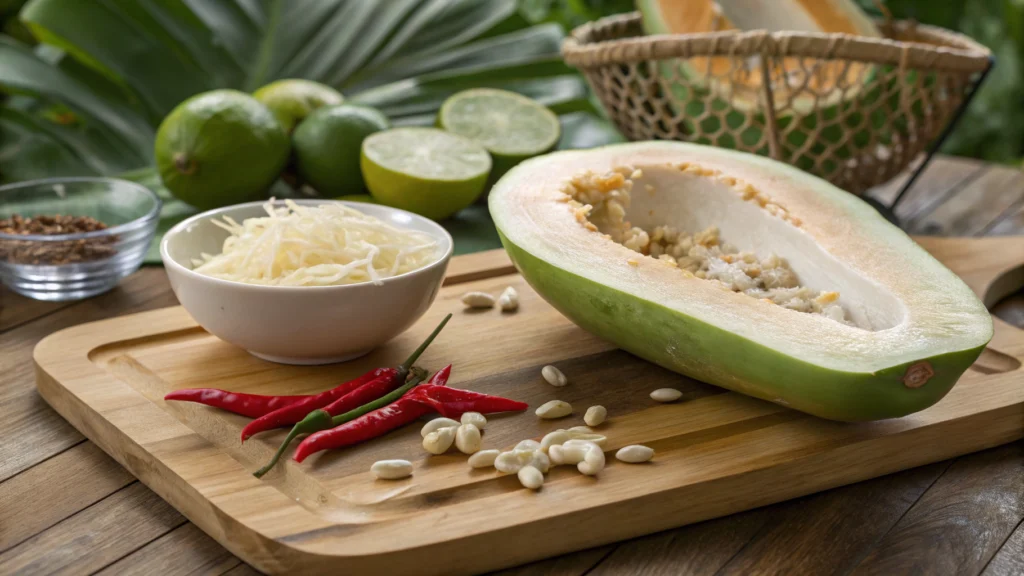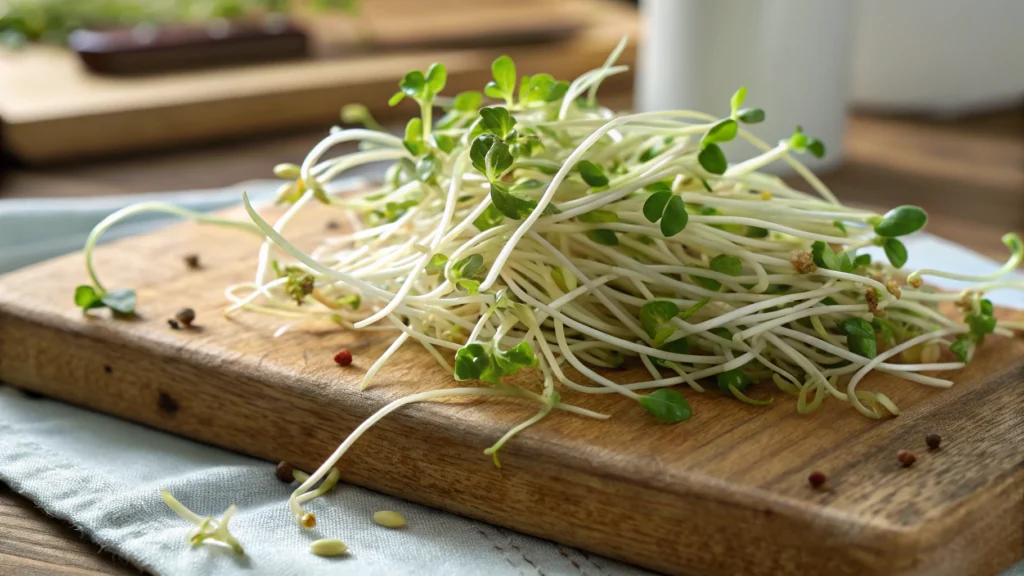
Green papaya, the unripe version of the papaya fruit, has been a staple in tropical cuisines for centuries. This versatile ingredient offers a unique taste profile and impressive nutritional benefits that make it a valuable addition to various dishes worldwide. Whether used in salads, curries, or as a meat tenderizer, green papaya continues to gain popularity among health-conscious consumers and culinary enthusiasts alike.
What is Green Papaya?
Green papaya is simply the unripe form of papaya (Carica papaya), harvested before the fruit has a chance to mature and develop its characteristic orange-yellow flesh. Unlike its ripe counterpart, green papaya has firm, pale flesh with a crisp texture similar to cucumber or jicama. The interior contains small, white immature seeds that are typically removed before consumption.
Green papaya contains papain, a powerful enzyme that breaks down proteins, making it an excellent natural meat tenderizer. This enzyme, along with its unique nutritional profile, contributes to its various culinary applications and health benefits. The fruit is particularly prominent in Southeast Asian cuisine, where it stars in popular dishes like Thai green papaya salad (Som Tam).
Origin and History of Green Papaya
Papaya is native to southern Mexico and Central America but has spread throughout tropical regions worldwide. Archaeological evidence suggests that papaya cultivation dates back to at least 2000 BCE in Mexico and was later introduced to the Caribbean, South America, and eventually across the Pacific to the Philippines, India, and other parts of Asia.
Spanish and Portuguese explorers played a significant role in spreading papaya throughout their colonies in the 16th and 17th centuries. The fruit quickly became incorporated into local cuisines, with green papaya emerging as a particularly valued ingredient in Southeast Asian cooking.
In Thailand, green papaya salad (Som Tam) originated in the northeastern region (Isaan) but has become one of the country’s most internationally recognized dishes. Similarly, in Vietnam, green papaya is used in salads like Gỏi Đu Đủ and soups. In Filipino cuisine, green papaya is a key ingredient in the chicken soup tinola, while in Indonesian and Malaysian cooking, it appears in various curries and stews.
What Does Green Papaya Taste Like?
Unlike sweet, aromatic ripe papaya, green papaya has a mild, subtly sweet flavor with slight peppery notes. Its taste is often compared to cucumber or chayote squash – neutral enough to absorb the flavors of other ingredients while providing a pleasant textural contrast.
The texture of green papaya is crisp and firm, similar to green apples or jicama. This crunchiness makes it perfect for salads and slaws where it maintains its integrity even when dressed. When cooked, green papaya softens but retains some firmness, making it suitable for soups, stews, and curries where it absorbs surrounding flavors while providing textural interest.
What is Green Papaya Used For?
Green papaya’s versatility extends across numerous culinary applications:
- Salads: Most famously used in Thai Som Tam, a spicy salad combining shredded green papaya with lime, fish sauce, chili, and palm sugar.
- Meat tenderizer: The papain enzyme breaks down tough meat fibers, making green papaya an excellent natural meat tenderizer in marinades.
- Soups and stews: Added to dishes like Filipino tinola or Vietnamese canh for texture and subtle flavor.
- Curries: Used in various Southeast Asian curries for its ability to absorb spices while maintaining structure.
- Pickles and preserves: Green-papaya makes excellent pickles due to its firm texture.
- Desserts: In some cultures, green-papaya is candied or used in sweet dishes.
- Medicinal purposes: Used in traditional medicine for digestive issues and skin applications.
Is Eating Green Papaya Good for You?
Green-papaya offers numerous health benefits supported by both traditional knowledge and scientific research:
According to a review published in the International Journal of Food Science and Nutrition, papain and chymopapain enzymes in green-papaya help improve digestion by breaking down proteins and relieving symptoms of digestive disorders (Source).
Research published in the Journal of Ethnopharmacology indicates that green-papaya contains compounds with anti-inflammatory and antioxidant properties that may help reduce inflammation and oxidative stress (Source).
Green-papaya is also lower in sugar compared to ripe papaya, making it a good option for those monitoring their sugar intake, according to the USDA Food Composition Database (Source).
What Are the Benefits of Green Papaya?
Green papaya provides several evidence-backed health benefits:
- Digestive Health: The rich enzyme content aids protein digestion and may relieve constipation. A study in the Journal of Medicinal Food demonstrated papaya’s effectiveness in treating digestive disorders (Source).
- Anti-inflammatory Properties: Research published in Molecular Nutrition & Food Research found that compounds in green-papaya can reduce inflammation markers (Source).
- Skin Health: Topical applications may promote wound healing and skin health due to papain’s ability to remove dead skin cells. The Journal of Medicinal Plants Studies confirms papaya’s traditional use in treating skin conditions (Source).
- Weight Management: Low in calories and high in fiber, green-papaya can support weight management goals according to the American Journal of Clinical Nutrition (Source).
- Immune Support: Rich in vitamin C and vitamin A precursors, it supports immune function, as noted in a review in Nutrients journal (Source).
🧀 Green Papaya Similarities
Green-papaya shares characteristics with several other foods:
- Cucumber: Both have high water content, mild flavor, and crunchy texture.
- Chayote: Similar neutral flavor profile and firmness.
- Green Mango: Both are used in Southeast Asian salads and have tartness.
- Jicama: Shares a crisp texture and ability to absorb flavors.
- Kohlrabi: Similar crunch and versatility in raw applications.
- Green Jackfruit: Both can be used as meat substitutes when cooked.
- Winter Melon: Similar texture when cooked and ability to absorb flavors in soups.
🧑🍳 Green Papaya vs Papaya
The Difference Between Green Papaya and Orange Papaya
While green-papaya and ripe papaya come from the same fruit, they differ significantly in several aspects:
Nutritional Profile:
- Green-papaya is higher in papain enzymes and lower in sugar.
- Ripe papaya contains more antioxidants like lycopene and beta-carotene.
- Green-papaya has more vitamin C, while ripe papaya offers more vitamin A.
Culinary Uses:
- Green-papaya is primarily used in savory dishes.
- Ripe papaya is commonly enjoyed fresh or in sweet applications.
Taste and Texture:
- Green-papaya: Mild, slightly peppery flavor with crunchy texture.
- Ripe papaya: Sweet, musky flavor with soft, juicy texture.
Digestive Effects:
- Green-papaya’s higher enzyme content makes it better for digestion aid.
- Both versions support digestion but in different ways.
Famous Recipes Using Green Papaya
- Thai Som Tam (Green Papaya Salad): A spicy salad with shredded green-papaya, lime juice, fish sauce, palm sugar, chilies, and peanuts.
- Vietnamese Gỏi Đu Đủ: Green-papaya salad with shrimp, herbs, and a tangy fish sauce dressing.
- Filipino Tinola: Chicken soup with green-papaya chunks, ginger, and chili leaves.
- Laotian Tam Mak Hoong: Similar to Som Tam but often spicier with more fermented flavors.
- Indonesian Sayur Pepaya Muda: Green-papaya soup with coconut milk and aromatic spices.
- Caribbean Green-Papaya Stew: Savory stew with salt meat, green-papaya, and island spices.
- Indian Papita Curry: Green-papaya curry with mustard seeds, curry leaves, and coconut.
- Atchara is a traditional Filipino condiment made from green-papaya, known for its distinct sweet and tangy pickled flavor that complements savory dishes.
Green Papaya FAQs
1. Can you eat green papaya raw?
Yes, green-papaya can be eaten raw. It’s commonly shredded for salads like Thai Som Tam. The raw fruit is crunchy with a mild flavor that absorbs dressings well.
2. How do you select a good green papaya?
Choose firm green-papayas with unblemished skin. The fruit should feel heavy for its size and have no soft spots. For culinary purposes, select ones with bright green skin without any yellow patches.
3. How do you store green papaya?
You can keep whole green-papayas at room temperature for several days without spoiling, making them convenient for short-term storage. Once cut, wrap tightly in plastic wrap and refrigerate for up to 3-4 days. Shredded green-papaya should be used immediately or will quickly discolor.
4. Is green papaya safe during pregnancy?
Unripe papaya contains concentrated papain which some studies suggest may induce contractions. Many healthcare providers recommend avoiding green-papaya during pregnancy, especially in the first trimester. Always consult your healthcare provider.
5. How do you prepare green papaya for cooking?
Peel the green skin with a vegetable peeler, cut the papaya in half lengthwise, scoop out the white seeds, and then slice or shred as required for your recipe.
6. Can green papaya help with digestion?
Yes, green-papaya contains digestive enzymes, particularly papain, which can help break down proteins and ease digestive discomfort. This makes it beneficial for digestion and is why it’s often used as a meat tenderizer.
7. What can I substitute for green papaya in recipes?
Good substitutes include cucumber, chayote, jicama, green mango, or kohlrabi, depending on the recipe. Each offers a similar crunchy texture though the flavor profiles vary slightly.
8. Does green papaya have any side effects?
Some people may experience allergic reactions. The latex in green-papaya can cause irritation for those with latex allergies. Excessive consumption may cause stomach upset due to the strong enzymatic action.
9. Can green papaya help with weight loss?
Green-papaya is a nutritious option for those watching their weight, thanks to its low calorie content and high fiber, which can help you feel full longer. Additionally, its natural enzymes may support better digestion, contributing to overall wellness and weight management when included in a balanced diet.
10. How long does it take for a green papaya to ripen?
If left at room temperature, a green-papaya will typically ripen within 3-7 days, depending on how unripe it was to begin with. To speed up the ripening process, try placing it in a paper bag alongside a banana or apple, which release natural ethylene gas that encourages faster ripening.
may also like it

